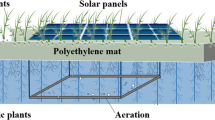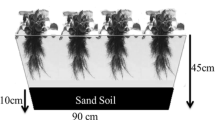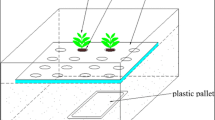Abstract
Floating treatment wetlands (FTWs) are a management method to improve urban rivers, but most studies have been carried out at laboratory, micro, and meso levels, so it is necessary to study full-scale FTWs as a method to improve urban water bodies. In this experiment, the purification effects of water temperature (WT), dissolved oxygen (DO), ammonia nitrogen (NH4+-N), nitrate nitrogen (NO3−-N), total phosphorus (TP), chemical oxygen demand (CODMn), and chlorophyll-a (Chl-a) under staggered arrangement (SA) and centered arrangement (CA) were evaluated. It was found that the DO concentration and removal rate of CODMn, Chl-a, and TP in the SA were significantly higher than those in the CA in months with heavy rainfall. However, interestingly, for TP, August showed the opposite trend. The removal rates of NH4+-N and NO3−-N were significantly different throughout the test period. The biomass growth values of shoots and roots of plants in the FTWs were 0.40 ± 0.03 kg/m2 and 1.38 ± 0.07 kg/m2 in the SA and 0.32 ± 0.07 kg/m2 and 1.26 ± 0.30 kg/m2 in the CA. The increments of N absorbed by plants in the SA and CA were 7.08 ± 0.49 g/kg and 6.83 ± 0.07 g/kg, respectively, and the increments of P were 0.57 ± 0.02 g/kg and 0.32 ± 0.07 g/kg, respectively, which indicated that the growth status of plants in the FTWs in the SA was slightly better than that in the CA. In summary, the hybrid-constructed FTWs of both arrangements can effectively improve the water quality of urban rivers, and the effect of the SA was greater than that of the CA. The purification effect of in situ tests under different arrangement modes of hybrid-constructed FTWs was evaluated, which provides guidance and support for the field layout of FTWs in rivers in the future.









Similar content being viewed by others
Data Availability
The datasets used and/or analyzed in this study are available by the corresponding author on reasonable request (qyn_2017tju@163.com).
References
Bhattacharya R, Mazumder D (2021) Simultaneous nitrification and denitrification in moving bed bioreactor and other biological systems Bioproc Biosyst Eng 44:635–652. https://doi.org/10.1007/s00449-020-02475-6
Borne KE, Fassman EA, Tanner CC (2013) Floating treatment wetland retrofit to improve stormwater pond performance for suspended solids, copper and zinc[J]. Ecol Eng 54:173–182. https://doi.org/10.1016/j.ecoleng.2013.01.031
Borne K (2014) Floating treatment wetland influences on the fate and removal performance of phosphorus in stormwater retention ponds. Ecol Eng 69:76–82. https://doi.org/10.1016/j.ecoleng.2014.03.062
Bu F, Xu X (2013) Planted floating bed performance in treatment of eutrophic river water. Environ Monit Assess 185:9651–9662. https://doi.org/10.1007/s10661-013-3280-6
Castro-Castellon AT, Chipps MJ, Hankins NP, Hughes JMR (2016) Lessons from the “Living-Filter”: an in-reservoir floating treatment wetland for phytoplankton reduction prior to a water treatment works intake. Ecol Eng 95:839–851. https://doi.org/10.1016/j.ecoleng.2016.07.023
Chang N, Xuan Z, Marimon Z, Islam K, Wanielista MP (2013) Exploring hydrobiogeochemical processes of floating treatment wetlands in a subtropical stormwater wet detention pond. Ecol Eng 54:66–76. https://doi.org/10.1016/j.ecoleng.2013.01.019
Chen M, Cui J, Lin J, Ding S, Gong M, Ren M et al. (2017) Successful control of internal phosphorus loading after sediment dredging for 6years: a field assessment using high-resolution sampling techniques. Sci Total Environ 616–617:927–936. https://doi.org/10.1016/j.scitotenv.2017.10.227
Coban O, Kuschk P, Wells NS, Strauch G, Knoeller K (2015) Microbial nitrogen trans-formation in constructed wetlands treating contaminated groundwater. Environ Sci Pollut Res 22:12829–12839. https://doi.org/10.1007/s11356-014-3575-3
Colares GS, Dell’Osbel N, Wiesel PG, Oliveira GA, Lemos PHZ, Da Silva FP, Lutterbeck CA, Kist LT, Machado ÊL (2020) Floating treatment wetlands: a review and bibliometric analysis. Sci Total Environ 714:136776. https://doi.org/10.1016/j.scitotenv.2020.136776
DeBusk TA, Peterson JE, Ramesh Reddy K (1995) Use of aquatic and terrestrial plants for removing phosphorus from dairy wastewaters. Ecol Eng 5:371–390. https://doi.org/10.1016/0925-8574(95)00033-X
De Stefanie G, Tocchetto D, Salvato M, Borin M (2011) Performance of a floating treatment wetland for in-stream water amelioration in NE Italy. Hydrobiologia 674:157–167. https://doi.org/10.1007/s10750-011-0730-4
Dong A, Li L, Dzakpasu M, Rong C, Tao X, Wang XC (2018) Replenishment of landscape water with reclaimed water: optimization of supply scheme using transparency as an indicator. Ecol Ind 88:503–511. https://doi.org/10.1016/j.ecolind.2018.01.007
Franco JA, Bañón S, Vicente MJ, Miralles J, Martínez-Sánchez JJ (2011) Root development in horticultural plants grown under abiotic stress conditions – a review. J Hortic Sci Biotech 86:543–556
Gao Y, Zhu Q, Huang Y, Yu M, Zhou Z (2020) Study on the influence of different ecological floating beds on water flow structure. J Hydraulic Eng 51:1423–1431
Ge Z, Feng C, Wang X, Zhang J (2016) Seasonal applicability of three vegetation constructed floating treatment wetlands for nutrient removal and harvesting strategy in urban stormwater retention ponds. Int Biodeter Biodegr 112:80–87. https://doi.org/10.1016/j.ibiod.2016.05.007
Hartshorn N, Marimon Z, Xuan Z, Cormier J, Chang N, Wanielista M (2016) Complex interactions among nutrients, chlorophyll-a, and microcystins in three stormwater wet detention basins with floating treatment wetlands. Chemosphere 144:408–419. https://doi.org/10.1016/j.chemosphere.2015.08.023
Headley T, Tanner C (2012) Constructed wetlands with floating emergent macrophytes: an innovative stormwater treatment technology. Crit Rev Environ Sci Technol 42:2261–2310. https://doi.org/10.1080/10643389.2011.574108
Kabenge I, Ouma G, Aboagye D, Banadda N (2018) Performance of a constructed wetland as an upstream intervention for stormwater runoff quality management. Environ Sci Pollut R 25:36765–36774. https://doi.org/10.1007/s11356-018-3580-z
Liu C, Shan Y, Lei J, Nepf H (2019) Floating treatment islands in series along a channel: The impact of island spacing on the velocity field and estimated mass removal. Adv Water Resour. 129:222–231. https://doi.org/10.1016/j.advwatres.2019.05.011
Lu H, Ku C, Chang Y (2015) Water quality improvement with artificial floating islands. Ecol Eng 74:371–375. https://doi.org/10.1016/j.ecoleng.2014.11.013
Lucke T, Walker C, Beecham S (2019) Experimental designs of field-based constructed floating wetland studies: a review. Sci Total Environ 660:199–208. https://doi.org/10.1016/j.scitotenv.2019.01.018
Ma C, Qiao Y, Bin L, Yao Y (2021) Performance of hybrid-constructed floating treatment wetlands in purifying urban river water: a field study. Ecol Eng 171:106372. https://doi.org/10.1016/j.ecoleng.2021.106372
Nichols P, Lucke T, Drapper D, Walker C (2016) Performance evaluation of a floating treatment wetland in an urban catchment. Water-Sui. 8. https://doi.org/10.3390/w8060244
Olguín EJ, Sánchez-Galván G, Melo FJ, Hernández VJ, González-Portela RE (2017) Long-term assessment at field scale of Floating Treatment Wetlands for improvement of water quality and provision of ecosystem services in a eutrophic urban pond. Sci Total Environ 584-585:561–571. https://doi.org/10.1016/j.scitotenv.2017.01.072
Rajta A, Bhatia R, Setia H, Pathania P (2020) Role of heterotrophic aerobic denitrifying bacteria in nitrate removal from wastewater. J Appl Microbiol 128:1261–1278. https://doi.org/10.1111/jam.14476
Rousseau D, Lesage E, Story A, Vanrolleghem P, De Pauw N (2008) Constructed wetlands for water reclamation. Desalination 218:181–189. https://doi.org/10.1016/j.desal.2006.09.034
Saeed T, Sun G (2012) A review on nitrogen and organics removal mechanisms in subsurface flow constructed wetlands: dependency on environmental parameters, operating conditions and supporting media. J Environ Manag 112:429–448
SEPAC (State Environmental Protection Administration of China) (2002) Monitoring and analysis method of water and wastewater [M]4th ed. China Environmental Science Press, Beijing
Sheng Y, Qu Y, Ding C, Sun Q, Mortimer RJG (2013) A combined application of different engineering and biological techniques to remediate a heavily polluted river. Ecol Eng 57:1–7. https://doi.org/10.1016/j.ecoleng.2013.04.004
Sukumaran D (2013) Phytoremediation of heavy metals from industrial effluent using constructed wetland technology. Appl Ecol Environ Sci 1:92–97. https://doi.org/10.12691/aees-1-5-4
Tanner CC, Headley TR (2011) Components of floating emergent macrophyte treatment wetlands influencing removal of stormwater pollutants. Ecol Eng 37:474–486. https://doi.org/10.1016/j.ecoleng.2010.12.012
Vyzamal J (2011) Plants used in constructed wetlands with horizontal subsurface flow: a review. Hydrobiologia 674:133–156. https://doi.org/10.1007/s10750-011-0738-9
Walaszek M, Bois P, Laurent J, Lenormand E, Wanko A (2018) Micropollutants removal and storage efficiencies in urban stormwater constructed wetland. Sci Total Environ 645:854–864. https://doi.org/10.1016/j.scitotenv.2018.07.156
Walker C, Tondera K, Lucke T (2017) Stormwater treatment evaluation of a constructed floating wetland after two years operation in an urban catchment. Sustainability-Basel, 9. https://doi.org/10.3390/su9101687
Wang C, Sample DJ (2014) Assessment of the nutrient removal effectiveness of floating treatment wetlands applied to urban retention ponds. J Environ Manag 137:23–35. https://doi.org/10.1016/j.jenvman.2014.02.008
Wang WH, Wang Y, Fan P, Chen LF, Chai BH, Zhao JC et al. (2018) Effect of calcium peroxide on the water quality and bacterium community of sediment in black-odor water. Environ Pollut 248:18–27. https://doi.org/10.1016/j.envpol.2018.11.069
Winston RJ, Hunt WF, Kennedy SG, Merriman LS, Chandler J, Brown D (2013) Evaluation of floating treatment wetlands as retrofits to existing stormwater retention ponds. Ecol Eng 54:254–265. https://doi.org/10.1016/j.ecoleng.2013.01.023
Wu CD, Xu XJ, Liang JL, Wang Q, Dong Q, Liang WL (2011) Enhanced coagulation for treating slightly polluted algae-containing surface water combining polyaluminum chloride (PAC) with diatomite. Desalination 279:140–145. https://doi.org/10.1016/j.desal.2011.06.007
Wu Q, Hu Y, Li S, Peng S, Zhao H (2016) Microbial mechanisms of using enhanced ecological floating beds for eutrophic water improvement. Bioresour Technol 211:451–456. https://doi.org/10.1016/j.biortech.2016.03.113
Xu B, Wang X, Liu J, Wu J, Zhao Y, Cao W (2017) Improving Urban Stormwater Runoff Quality by Nutrient Removal through Floating Treatment Wetlands and Vegetation Harvest. Sci Rep-Uk, 7. https://doi.org/10.1038/s41598-017-07439-7
Xu J, Wu X, Ge X, Tian Y, Ma X, Li Y, Xu X, Li Z (2021) Variations of Concentration Characteristics of Rainfall Runoff Pollutants in Typical Urban Living Areas. B Environ Contam Tox 106:608–613. https://doi.org/10.1007/s00128-021-03110-0
Yu H, Xiao R, Zhou X (2020) Study plant photosynthetic characteristics of canna glauca and hydrocotyle vulgaris and their removal effects on nitrogen and phosphorus. Ecol Environ Sci 29:1014–1020
Acknowledgements
The authors are grateful for the financial support from the Major Science and Technology program for Water Pollution Control and Treatment, Ministry of Ecology and Environment of China [grant number 2017ZX07106-004], the Natural Science Foundation of China [grant number 52079087] and the Tianjin Research Innovation Project for Postgraduate Students [grant number 2021YJSB136]. We are also thankful to all our laboratory colleagues and research staff members for their constructive advice and help.
Funding
This study was supported by the Major Science and Technology program for Water Pollution Control and Treatment, Ministry of Ecology and Environment of China [grant number 2017ZX07106-004], the Natural Science Foundation of China [grant number 52079087] and the Tianjin Research Innovation Project for Postgraduate Students [grant number 2021YJSB136].
Author information
Authors and Affiliations
Contributions
All authors contributed to the study conception and design. Material preparation, data collection and analysis were performed by Yanan Qiao. Manuscript conception and design were performed by Chao Ma. The first draft of the manuscript was written by Chao Ma. Manuscript revision and grammar correction were performed by Kui Xu, and all authors commented on previous versions of the manuscript. All authors read and approved the final manuscript.
Corresponding author
Ethics declarations
Conflict of Interest
The authors declare no competing interests.
Consent to Participate
Informed consent was obtained from all individual participants included in the study.
Additional information
Publisher’s note Springer Nature remains neutral with regard to jurisdictional claims in published maps and institutional affiliations.
Rights and permissions
About this article
Cite this article
Qiao, Y., Ma, C. & Xu, K. Nutrient Removal by Floating Treatment Wetlands Under Different Spatial Arrangement Modes: a Field Study. Environmental Management 70, 420–430 (2022). https://doi.org/10.1007/s00267-022-01677-w
Received:
Accepted:
Published:
Issue Date:
DOI: https://doi.org/10.1007/s00267-022-01677-w




